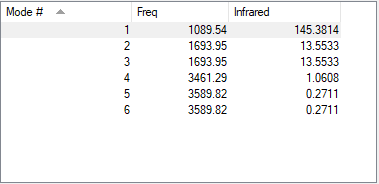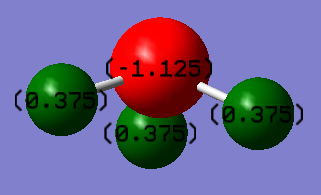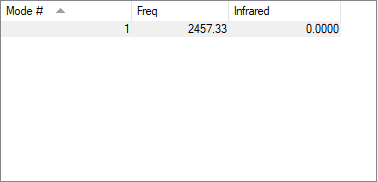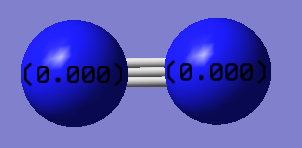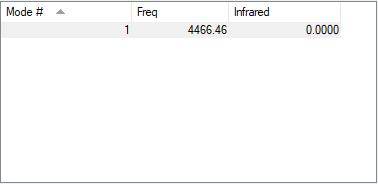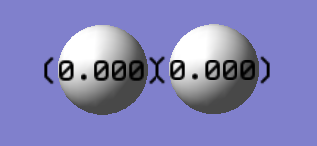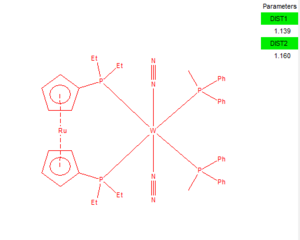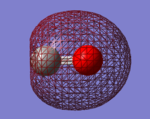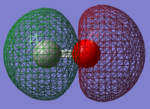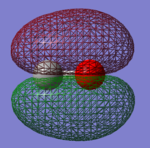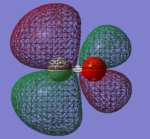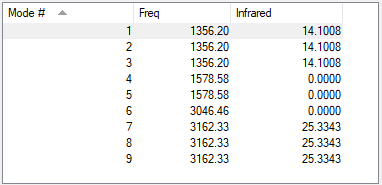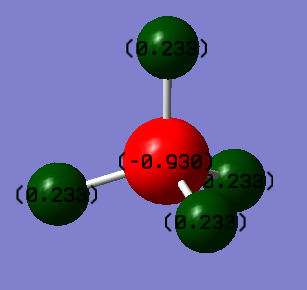Rep:Mod:SJL1218
NH3 Molecule
NH3 Optimisation Summary
| Molecule | NH3 |
| Calculation Method | RB3LYP |
| Basis Set | 6-31G(d,p) |
| E(RB3LYP) | -56.55776873 |
| RMS Gradient Norm | 0.00000485 |
| Point Group | C3V |
NH3 Items List, Model and Structural Information
Item Value Threshold Converged?
Maximum Force 0.000004 0.000450 YES
RMS Force 0.000004 0.000300 YES
Maximum Displacement 0.000072 0.001800 YES
RMS Displacement 0.000035 0.001200 YES
Predicted change in Energy=-5.986271D-10
Optimization completed.
-- Stationary point found.
Ammonia |
N-H bond distance: 1.02Å
H-N-H bond angle: 106°
NH3 Vibrations and Atomic Charges
Vibrational Modes
| Wavenumber cm-1 | 1090 | 1694 | 1694 | 3461 | 3590 | 3590 |
| Symmetry | A1 | E | E | A1 | E | E |
| Intensity (arbitary units) | 145 | 14 | 14 | 1 | 0 | 0 |
| Image | 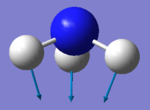
|

|

|

|

|

|
NH3 Vibrations Questions
How many modes do you expect from the 3N-6 rule?
3(4 atoms)-6 = 6 vibrational modes.
Which modes are degenerate?
Two modes with wavenumber 1694cm-1 and two modes with wavenumber 3590cm-1 are degenerate.
Which modes are "bending" vibrations and which are "bond stretch" vibrations?
Bending modes: 1090cm-1, 1694cm-1.
Vibrational modes: 3461cm-1, 3590cm-1.
Which mode is highly symmetric?
Vibrational mode 3461cm-1 is highly symmetric
One mode is known as the "umbrella" mode, which one is this?
Bending mode 1090cm-1
How many bands would you expect to see in an experimental spectrum of gaseous ammonia?
4 bands
Atomic Charges
Nitrogen Charge: -1.125C
Hydrogen Charge: 0.375C
Nitrogen is expected to have a negative charge because it is more electronegative, and hydrogen to be positive because it it less electronegative.
N2 and H2 Molecule
N2 Optimisation Summary
| Molecule | N2 |
| Calculation Method | RB3LYP |
| Basis Set | 6-31G(d,p) |
| E(RB3LYP) | -109.52412868 |
| RMS Gradient Norm | 0.00000003 |
| Point Group | D*H |
N2 Items List, Model and Structural Information
Item Value Threshold Converged?
Maximum Force 0.000000 0.000450 YES
RMS Force 0.000000 0.000300 YES
Maximum Displacement 0.000000 0.001800 YES
RMS Displacement 0.000000 0.001200 YES
Predicted change in Energy=-1.075650D-15
Optimization completed.
-- Stationary point found.
Nitrogen |
N-N bond distance: 1.11Å
N2Vibrations and Atomic Charges
Vibrational Modes
| Wavenumber cm-1 | 2457 |
| Symmetry | SGG |
| Intensity (arbitary units) | 0 |
| Image | 
|
Atomic Charges
Nitrogen Charge: 0C
Same atom so there are no electronegative differences.
H2 Optimisation Summary
| Molecule | H2 |
| Calculation Method | RB3LYP |
| Basis Set | 6-31G(d,p) |
| E(RB3LYP) | -1.17853936 |
| RMS Gradient Norm | 0.00002276 |
| Point Group | D*H |
H2 Items List, Model and Structural Information
Item Value Threshold Converged?
Maximum Force 0.000039 0.000450 YES
RMS Force 0.000039 0.000300 YES
Maximum Displacement 0.000052 0.001800 YES
RMS Displacement 0.000073 0.001200 YES
Predicted change in Energy=-2.043043D-09
Optimization completed.
-- Stationary point found.
Hydrogen |
H-H bond distance: 0.72Å
H2 Vibrations and Atomic Charges
Vibrational Modes
| Wavenumber cm-1 | 4466 |
| Symmetry | SGG |
| Intensity (arbitary units) | 0 |
| Image | 
|
Atomic Charges
Hydrogen Charge: 0C
Same atom so there are no electronegative differences.
N2 Conquest Search
Mono-metallic TM complex that coordinates N-N
Formula: C44H54N4P4RuW
Name: (1,1'-bis(Diethylphosphino)ruthenocene-P,P')-bis(dinitrogen-N)-bis(diphenyl(methyl)phosphino)-tungsten
Unique Identifier: CUHVAD
link to CCDC: [[1]]
N-N bond distance in diatomic N2: 1.11Å
N-N bond distances in C44H54N4P4RuW: 1.14Å and 1.16Å[1]
The N-N bond in tungsten transition metal complex has a longer and weaker bond than on its own as a molecule. This is due to the electron withdrawal property of the tungsten cation; electron density shifts from the N-N domain to the centre of the complex. Thus, the bond order of the N-N bond decreases, suggesting that the bond is weakened and increases in length. The experimental value will be the exact value whereas the bond length found using Gaussian is only an approximation, not taking into account any ionic character or other factors involved.
The Haber-Bosch process
N2 + 3H2 → 2NH3
E(NH3)= -56.5577687 a.u.(7 d.p)
2*E(NH3)= -113.1155375 a.u. (7 d.p)
E(N2)= -109.5240412 a.u. (7 d.p)
E(H2)= -1.1785394 a.u. (7 d.p)
3*E(H2)= -3.5356181 a.u. (7 d.p)
ΔE= 2*E(NH3)-[E(N2)+3*E(H2)]= -0.0557907 a.u. (6 d.p)
ΔE= -146.5 kJ mol-1
The products are more stable because the reaction is exothermic so ammonia will end up with lower energy.
Choice of Small Molecule- CO
CO Optimisation Summary
| Molecule | CO |
| Calculation Method | RB3LYP |
| Basis Set | 6-31G(d,p) |
| E(RB3LYP) | -113.30945314 |
| RMS Gradient Norm | 0.00000202 |
| Point Group | C*V |
CO Items List, Model and Structural Information
Item Value Threshold Converged?
Maximum Force 0.000004 0.000450 YES
RMS Force 0.000004 0.000300 YES
Maximum Displacement 0.000001 0.001800 YES
RMS Displacement 0.000002 0.001200 YES
Predicted change in Energy=-4.844559D-12
Optimization completed.
-- Stationary point found.
Carbon Monoxide |
C-O bond distances: 1.14Å
CO Vibrations and Atomic Charges
Vibrational Modes
| Wavenumber cm-1 | 2209 |
| Symmetry | SG |
| Intensity (arbitary units) | 68 |
| Image | 
|
Atomic Charges
Carbon Charge: 0.506C
Oxygen Charge: -0.506C
Oxygen has a negative charge because it is more electronegative than carbon.
CO Molecular Orbitals
CH4 Molecule
| Molecule | NH3 |
| Calculation Method | RB3LYP |
| Basis Set | 6-31G(d,p) |
| E(RB3LYP) | -40.52401404 |
| RMS Gradient Norm | 0.00003263 |
| Point Group | TD |
CH4 Items List, Model and Structural Information
Item Value Threshold Converged?
Maximum Force 0.000063 0.000450 YES
RMS Force 0.000034 0.000300 YES
Maximum Displacement 0.000179 0.001800 YES
RMS Displacement 0.000095 0.001200 YES
Predicted change in Energy=-2.256043D-08
Optimization completed.
-- Stationary point found.
Methane |
C-H bond distance: 1.09Å
H-C-H bond angle: 109°
CH4 Vibrations and Atomic Charges
Vibrational Modes
| Wavenumber cm-1 | 1356 | 1356 | 1356 | 1579 | 1579 | 3046 | 3162 | 3162 | 3162 |
| Symmetry | T2 | T2 | T2 | E | E | A1 | T2 | T2 | T2 |
| Intensity (arbitary units) | 14 | 14 | 14 | 0 | 0 | 0 | 25 | 25 | 25 |
| Image | 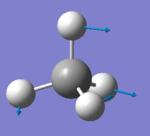
|

|
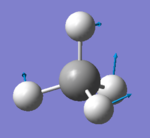
|

|
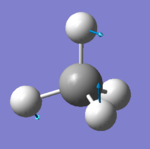
|
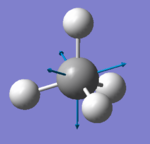
|
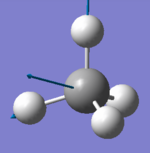
|
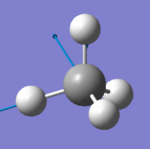
|
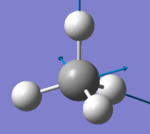
|
Atomic Charges
Carbon Charge: -0.930C
Hydrogen Charge: 0.233C
Carbon has a negative charge because it is more electronegative than hydrogen.
- ↑ M.Yuki, T.Midorikawa, Y.Miyake, Y.Nishibayashi CCDC 759201: Experimental Crystal Structure Determination, 2010.
Marking
Note: All grades and comments are provisional and subject to change until your grades are officially returned via blackboard. Please do not contact anyone about anything to do with the marking of this lab until you have received your grade from blackboard.
Wiki structure and presentation 1/1
Is your wiki page clear and easy to follow, with consistent formatting?
YES
Do you effectively use tables, figures and subheadings to communicate your work?
YES
NH3 0.5/1
Have you completed the calculation and given a link to the file?
YES
Have you included summary and item tables in your wiki?
YES
Have you included a 3d jmol file or an image of the finished structure?
YES
Have you included the bond lengths and angles asked for?
YES
Have you included the “display vibrations” table?
YES
Have you added a table to your wiki listing the wavenumber and intensity of each vibration?
YES
Did you do the optional extra of adding images of the vibrations?
YES
Have you included answers to the questions about vibrations and charges in the lab script?
YES, most answers are correct. However there are only 2 visible peaks in the spectra of NH3, due to the low intensity of the other 2 peaks. (See infrared column in vibrations table.)
N2 and H2 0.5/0.5
Have you completed the calculations and included all relevant information? (summary, item table, structural information, jmol image, vibrations and charges)
YES
Crystal structure comparison 0.5/0.5
Have you included a link to a structure from the CCDC that includes a coordinated N2 or H2 molecule?
YES
Have you compared your optimised bond distance to the crystal structure bond distance?
YES
Haber-Bosch reaction energy calculation 1/1
Have you correctly calculated the energies asked for? ΔE=2*E(NH3)-[E(N2)+3*E(H2)]
YES
Have you reported your answers to the correct number of decimal places?
YES
Do your energies have the correct +/- sign?
YES
Have you answered the question, Identify which is more stable the gaseous reactants or the ammonia product?
YES
Your choice of small molecule 4.5/5
Have you completed the calculation and included all relevant information?
YES
Have you added information about MOs and charges on atoms?
YES, very good explanations overall. However the LUMO does not have an effect on the bonding within the molecule as it is unoccupied so does not effect the electrons or interactions in the molecule. In a reaction it could become at least partially occupied so it would have an impact on reactivity.
Independence 1/1
If you have finished everything else and have spare time in the lab you could:
Check one of your results against the literature, or
Do an extra calculation on another small molecule, or
You calculated CH4, well done!
Do some deeper analysis on your results so far

